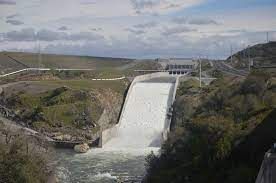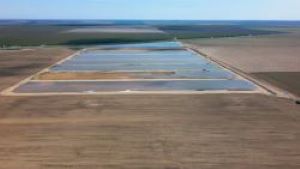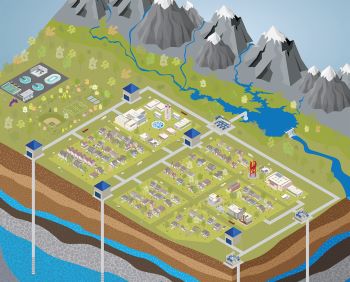Reaping The Benefits Of A Wet Winter
Published on by Water Network Research, Official research team of The Water Network in Technology
Reaping the benefits of a wet winter
Flood flows provided by Reclamation boost groundwater recharge
Media Contact: Gary Pitzer (916) 978-5107 gpitzer@usbr.gov
For Release: Aug 15, 2023
Water flows from Folsom Dam's Auxiliary Spillway
 Central Valley Project contractors accessed hundreds of thousands of acre-feet of floodwater provided by Reclamation in 2023, recharging groundwater basins that are a critical part of California’s water supply.
Central Valley Project contractors accessed hundreds of thousands of acre-feet of floodwater provided by Reclamation in 2023, recharging groundwater basins that are a critical part of California’s water supply.
The influx of water has been a welcome respite after the driest three-year stretch ever recorded in California. The winter months saw a series of atmospheric rivers rolling through the Sierra Nevada, building a mountain of snow that remained well into the spring and summer.
Central Valley Project reservoirs reaped the benefits, gaining almost 7 million acre-feet of storage since Dec. 1, with Shasta leading the way with more than 3 million acre-feet of increased storage.
During the brunt of the storms and afterward, large amounts of runoff had to be safely conveyed through the Sacramento-San Joaquin Valley to alleviate any flood danger. Some of this water, known as “Section 215” was made available to those CVP contractors who had the capability to take it.
Take the water they did, well into the spring and summer. The water went everywhere, from the Sacramento Valley and American River Basin in the north to areas south of the Delta, including wildlife refuges, and the wide stretch of land adjacent to the San Joaquin River. With large, non-storable runoff fading, Section 215 supplies were last made available on July 29, much later than most other wet years. Significant progress was made this year in recharge groundwater basins. In most years, groundwater accounts for about 40 percent of California’s water supply. That figure increases to 60 percent during dry years. During a time of increasingly wide weather extremes in California, the availability of floodwater for groundwater recharge is crucial.
“Groundwater is a vital component for many of our contractors’ water supply portfolio, and we are pleased that so much of this year’s flood flow was accessed to recharge depleted groundwater basins,” said Reclamation’s California-Great Basin Regional Director Ernest Conant.
Communities that relied on surface water deliveries have struggled under the weight of severe droughts that slashed CVP contract allocations to zero and forced even greater reliance on groundwater. Now, with the mandates of the state of California’s Sustainable Groundwater Management Act (SGMA) in effect, it’s imperative that water purveyors and landowners pursue as much groundwater recharge as possible when the opportunity exists.
“It's the path to long-term sustainability and SGMA compliance,” said Scott Petersen, water policy director with the San Luis and Delta-Mendota Water Authority. “That's just fundamentally the reality of what that looks like.”
Authority members are recharging groundwater basins through a variety of means, depending on location and geology, Petersen said, adding that in some cases it’s merely a matter of disking a field, putting water on it, and allowing it to slowly percolate underground. Westlands Water District accessed about 122,000 acre-feet of Section 215 water, more than three times the amount taken in 2019. The combination of a full contract allotment and the availability of Section 215 water meant that lands that otherwise would not have received an allocation had their requests fully satisfied, further reducing groundwater use.
The bonus water in the system eases the reliance on groundwater, according to Elizabeth Jonasson, public affairs representative with Westlands. She noted that in 2017, landowners in the district’s pumped 54,000 acre-feet of groundwater. This year that figure is expected to be about 10,000 acre-feet.

Groundwater recharge in Westlands Water District
“Preserving groundwater and promoting in-lieu recharge will enhance the district’s drought resiliency and prepare us for future low CVP allocations,” said Jonasson.
On the east side of the San Joaquin Valley, hundreds of thousands of acre-feet of floodwaters were released and conveyed through the Friant Dam system for groundwater recharge and other beneficial purposes. All told, Reclamation’s Friant contractors took about 600,000 acre-feet of floodwater in addition to their contract supplies, most of which was recharged to groundwater aquifers. Also in the mix, more than 20,000 acre-feet of Friant Dam releases were taken by downstream wildlife refuges.
Johnny Amaral, chief operating officer with Friant Water Authority, said his members have seized upon the opportunity presented with the large flows.
“When there is a drop of water, especially flood water, that’s made available, the vast majority of contractors are talking every drop they can get to get it underground, especially when there is no irrigation demand,” he said.
Recharging groundwater basins also benefits the many small communities within the Friant Division that are almost entirely dependent on groundwater for their drinking water supply. “The fact that we have been able to take as much water as we have and get it into the ground – it obviously raises water levels and improves water quality,” said Amaral.
In Northern California, more than 46,000 acre-feet of Section 215 water was picked up by16 water districts serving growers in Colusa, Glenn, Shasta, Tehama and Yolo counties.

The city of Roseville's Aquifer Storage and Recovery System
On the urban side, the city of Roseville and the Sacramento Suburban Water District collectively accessed more than 3,600 acre-feet. Roseville, which has an extensive aquifer storage and recovery system, calculates the extra water is enough to serve about 6,000 homes for a year’s time, according to Sean Bigley, assistant environmental utilities director.
The flood flows have peaked, but the effort to grab future flood flows and recharge groundwater basins will continue to expand.
“I think you'll start seeing more creative partnerships between districts and landowners … which is a welcome sight,” said Amaral. “When water is available, we just have to make sure that we're taking it and putting it to good use.”
Taxonomy
- Groundwater Recharge
- Groundwater Quality & Quantity
- Groundwater Resource
- Groundwater Remediation